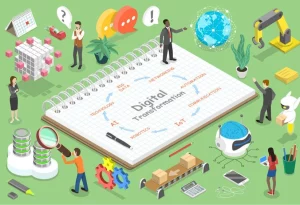Do you see your website, CRM, social media, and other digital initiatives as a way to improve service levels, market your organization, or be a central part of your thought leadership strategy? While important, at best these are tactical approaches: too often the bigger opportunity of digital transformation is ignored.
This isn’t surprising, as digital initiatives are often driven from marketing or IT, not from the board or the CEO. When it is driven from the top, the question is more about digital transformation and the disruptive business models that the organization might adopt: after all, it is better to be a disruptor than be disrupted. Here are seven:
- White label: In this model, your organization provides a behind-the-scenes capability that others can incorporate into their offerings. A related strategy is co-branding, where your capability is “co-branded” with an organization who has client relationships.
- Vertical integration: Think of the value chain, and particularly the functions both before and after your organization interacts with your key stakeholders. Many accounting firms, for example, also provide bookkeeping services. Amazon is now getting into the freight and delivery business, both with drone delivery at one end, and the purchase of a fleet of 40 Boeing 767 cargo planes.
- Software as a service: This is the quintessential capacity rental business, made popular by Salesforce, but now adopted by many. Other examples include Microsoft Office 365 and Adobe Creative Cloud.
- Toolmaker: This strategy is one where you build “tools” that others incorporate into their processes and their technology. Stripe, the online payments processor, specializes in building developer tools that enable ecommerce.
- Debundling: Instead of thinking of your organization as a single entity, is it possible to unbundle it and optimize each part? A newspaper, for example, could think of itself as a content producer, a printer, a delivery/logistics operation, and an ad sales organization. Even these can be debundled: a content producer, for example is really reporting, writing, and editing.
- Shared service provider: Associations at one point operated almost as a private club – a guild. Modern associations, on the other hand, are far more experienced, and have operations including advocacy, accreditation, certification, training, event management, community building, job/career boards, and more. But what if they built a shared service capacity, providing all manner of for-profit services for their members? As they know more about the industry than anyone else, there may be possibilities for procurement, portfolio management, accounting, logistics, and more.
- Crowdsourcing: This model brings key stakeholders directly into the business model itself: YouTube is built with user-generated content, Uber is built with independent drivers, AirBNB is built using homeowners.
While not every organization might choose to be disruptive, the thinking behind it is important… and should weigh into the digital investment decision.
This week’s action plan: Is your organization thinking of digital transformation? If so, how much time has been spent considering the connection to your organization’s business model? This week, choose one of these models, and whiteboard the digital implications.











